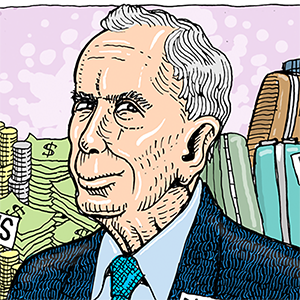From newspapers to fast food: What the new era of retail kiosks means for consumers
Published in Slideshow World
Subscribe
From newspapers to fast food: What the new era of retail kiosks means for consumers
America is poised for a high-tech reemergence of the technology once used to dispense newspapers and sell goods to commuters in busy thoroughfares a century ago.
Digital kiosks are taking over restaurant spaces across the country. A whopping 44% of restaurant brands surveyed by retail tech company Qu anticipated adding self-serve kiosks to stores in 2024.
The RealReal analyzed archived news reports and industry survey data to trace the history of kiosk and self-service technology from the 1800s to modern-day fast-food restaurants, where they're finding renewed appeal.
Kiosks have been a part of consumer retail culture since the early 1900s. With minimal—if not zero—employees operating them, kiosks take the form of small booths and stands, as well as self-operated racks or machines that dispense goods. Kiosks now also use internet-connected digital displays.
It's easy to overlook the pervasiveness of kiosks in our everyday lives. They're in airports and train stations, dispensing tickets to travelers; in convenience stores, enabling you to withdraw and deposit cash with your bank; and in grocery stores, allowing for speedy self-checkout.
Bolstered by today's computer algorithms, the technology benefits consumers and business owners by introducing convenience and cutting the cost of doing business. A growing number of consumers, especially younger generations, find them preferable to queueing up for a human-operated checkout counter.
Visit thestacker.com for similar lists and stories.
The staying power of a cost-effective creation
The kiosk emerged as a technology-forward solution, allowing business owners to save money and boost profit.One of the oldest kiosks is the 7-foot-tall weather kiosk, installed in 1912 in Knoxville, Tennessee, which provided information about meteorological trends to passersby.
Different iterations of the vending machine have been introduced since the late 1800s. The coin-operated newspaper vending machine was invented in 1947, replacing the young men who hawked newspapers in the town square. By 1970, IBM and American Airlines had installed the first self-service ticketing kiosk in Chicago's O'Hare International Airport. In 1994, camera and film manufacturer Kodak installed the first self-service kiosks for developing film photography.
Kiosks have continuously captured entrepreneurs' interest with their flexibility, accessibility, and low overhead costs—a factor that's only become increasingly appealing as major in-person retail locations started losing consumer foot traffic in the digital era.
A moment for malls, machines, and self-service tech
You might not find film photography kiosks anymore, but mall kiosks attended by humans still exist today—50 years after they began appearing in shopping malls in the late 1970s. As the retail meccas entered their heyday around the turn of the century, these retail setups were particularly effective at capturing foot traffic and impulse purchases from passersby.
Whereas permanent mall storefronts have become difficult for mall landlords to fill, human-operated kiosks still remain because they can often be rented for a fraction of the cost. Alongside them, self-service tech and advanced vending machines dispensing things like high-priced tech toys from Best Buy or DVDs from Redbox took root in the 2000s.
Mall kiosks, however, are fewer and farther between in the consumer experience, as malls have seen declining interest and major retailers have pulled out of them.
By contrast, kiosks are seemingly appearing everywhere in the retail food industry. This slowly began a decade ago and has ramped up since the disruption of the COVID-19 pandemic.
Restaurant chain Panera Bread was among the pioneers who first experimented with self-service kiosks in restaurants. Facing increased competition in the fast-casual, healthy eating market, the company began overhauling its restaurants in 2014 with self-service kiosks, an initiative it called "Panera 2.0." The overhauled stores quickly became some of its top performers.
Once just a novelty in a few restaurants willing to experiment, kiosks are poised to burgeon throughout your favorite restaurants in the coming years—if they haven't shown up already.
Pursuing convenience and loyalty with algorithms and dynamic prices
As restaurant wages rise and industry employment has crept back to pre-COVID-19 levels, kiosks are finding new appeal with restaurant owners. And no longer as an experiment, but as a strategy for growth during a period of high costs.
Josh Kobza, CEO of Restaurant Brands International, which owns Burger King and Popeyes, told investors they're seeing consumers warm up to the technology in the past year. Shake Shack now has kiosks in approximately 95% of its restaurants, according to its most recent earnings report. Its executives found that customers spend more ordering from kiosks and that using them required 50 fewer hours of paid labor per week. McDonald's has had digital kiosks in its stores since 2020. As of October 2023, Taco Bell had ordered kiosks for at least 7,000 of its restaurants in the U.S. now. And if a major chain isn't already installing them, they're piloting or planning to install them soon.
Restaurant chains are betting that kiosks can help them build loyalty by improving the customer experience, just as self-service ticket kiosks in airports have been shown to increase customer satisfaction. The kiosks eliminate long waits to order and use more targeted marketing and order histories that follow the customer, creating a more personalized experience.
The new era of kiosks may also change how food is priced. Almost 40% of brands surveyed by Qu intend to leverage artificial intelligence to implement dynamic pricing—something digital menu boards and kiosks now make possible.
Previously, a business owner had to physically change the price of one of the goods in their vending machine, newsstand, or restaurant. Restaurant happy hour discounts were offered at fixed, predictable times. Soon, discounts and upcharges may change in a matter of seconds as an algorithm recognizes changes in customer demand for individual items on a menu.
It won't be new. Airline tickets operate on a dynamic price model that experts say keeps the companies operating and profitable. Still, kiosks may usher in an era where that kind of pricing is more pervasive than in the past. And if history is our guide, the digital kiosks of the 21st century may be here to stay. At least for the foreseeable future.
Story editing by Shannon Luders-Manuel. Copy editing by Paris Close.
This story originally appeared on The RealReal and was produced and distributed in partnership with Stacker Studio.










Comments